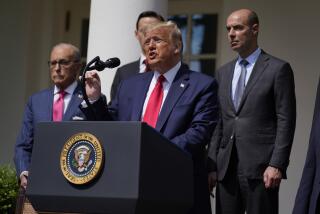Economic Ills May Boost Unions
- Share via
Union leaders made their now-familiar “Our-Great-Days-Are-Coming” Labor Day speeches last week, but the harsh fact remains that as things stand the future of organized labor in the United States looks bleak.
In the 1950s, unions represented 35% of private sector workers in America. Today, they represent 13%, by far the lowest percentage in any industrialized country in the world.
Even more discouraging are recent studies by experts--and not anti-union ones--predicting that by the year 2000, only 5% of America’s private sector workers will be union members.
That grim prospect could change if, among other things, unions can carry out their latest pledge to intensify use of one of their oldest but often neglected functions: organizing new members.
This may be an opportune time for such a campaign. A new, comprehensive report by the Economic Policy Institute on the steadily deteriorating lot of most American workers suggests that, for the first time in years, many may be ready to listen to union organizers.
Lawrence Mishel, an author of the report, “The State of Working America,” says that as the country slips into a recession, the average working family is much worse off than when we moved into previous recessions.
That means that workers won’t be able to weather a recession as well as they did in the past. While workers obviously need help, as the report clearly shows, that doesn’t mean that they will rush to join unions in massive numbers, as they did in the Depression years. But their increasing economic troubles these days should make the arguments of organizers more persuasive.
To encourage them to join, the national AFL-CIO has for the first time started recruiting and training what it calls a new generation of young, idealistic union organizers from the Peace Corps, political staffs, college campuses, community groups and local unions.
The unprecedented program should add momentum to the organizing drives that many individual unions are already intensifying.
Wisely, the still small national program is concentrating on women and minorities. They could be the most receptive to organizing efforts because their wages and benefits remain substantially below those of white males.
The 312-page institute study leaves little doubt about the economic problems of most workers.
It spells out the spectacular income growth of the wealthy and the steadily diminishing income of the average worker. It shows that near-record numbers of workers have been forced to take second jobs to maintain their standard of living.
The gap between the wealthy and the average American widened in part because of the loss of many well-paid, unionized factory jobs, overall loss of labor’s strength and the handsome tax advantages that began flowing to the rich soon after Ronald Reagan became President in 1981.
The report also showed that not only did average real hourly wages of workers drop by nearly 10% during the Reagan-Bush years, but that younger workers’ basic wages today are substantially less than those earned by young people a decade ago.
One particularly shocking figure: Young black men today earn 21.6% less than their counterparts a decade ago, after inflation is taken into account.
Even though more women than ever are working, home ownership by young families has dropped nearly 8% in the past 10 years--because even the combined incomes of husbands and wives are often no longer enough to buy a house.
Traditionally, there has been a wage and fringe benefit advantage for union workers, although it hasn’t resulted in union membership gains. That well-known income differential could bolster labor’s renewed organizing efforts, in view of the worsening economic plight of most workers and the probability of a recession exacerbated by the Middle East crisis.
The difference between union and non-union wages has diminished somewhat in recent years because of job losses in union factories and increasingly tough employers. Nevertheless, the institute study showed that white males in unions earn 18.8% more than their non-union counterparts.
The union advantage is far more dramatic for blacks, Latinos and women.
Unionized blacks and Latinos earn 55% more than those who are not union members, and the union advantage for women is 33.4%. Those facts should be useful to organizers.
Of course, more is needed to improve the fortunes of unions that have helped millions of workers get decent incomes and move into the middle class. Congress must pass some reasonable measures to ease repressive labor laws, such as the ridiculous one that allows employers to “permanently replace” striking workers, even though they cannot be fired for exercising their legal right to strike.
Labor law reform has to be adopted by a margin wide enough to override a certain veto by the anti-union Bush, and that is most unlikely until more pro-labor candidates are elected to Congress.
Unions must also vigorously pursue their battles against vicious anti-union employers--to persuade other employers that cooperation with labor is preferable to labor wars. Workers and their unions don’t always win such battles, but some do--like the coal miners, who set a fine example with their recent lengthy, successful strike.
Even when there is no clear-cut victory, unions can improve their status when they show that the cost of doing battle against them is prohibitively high, as workers are doing in strikes against Eastern Airlines and Greyhound Lines Inc.
Maybe before too many more Labor Days go by, unions will regain some of their old vigor, which will help balance the growth of corporate power. More important, perhaps future studies by the Economic Policy Institute will show happier times for the average American worker.
More to Read
Get the L.A. Times Politics newsletter
Deeply reported insights into legislation, politics and policy from Sacramento, Washington and beyond. In your inbox twice per week.
You may occasionally receive promotional content from the Los Angeles Times.










